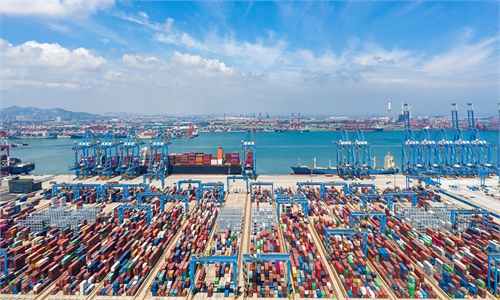
The Belize-registered tanker "Vesna" from Singapore, loaded with more than 96,000 tons of crude oil with a total value of about 800 million yuan, slowly docks at Dongying Port, East China's Shandong Province on November 15, 2023. Photo: VCG Tourists dance with artists at the Yotkan cultural scenic spot in Hotan County, northwest China's Xinjiang Uygur Autonomous Region, Nov. 7, 2023. The Yotkan cultural scenic spot is a small town featuring unique attraction that integrates culture, tourism, commerce and leisure. Performances elaborating its historical events are provided to tourists every night, allowing them to be immersed in the splendor of the ancient Silk Road.(Photo: Xinhua)
Tourists dance with artists at the Yotkan cultural scenic spot in Hotan County, northwest China's Xinjiang Uygur Autonomous Region, Nov. 7, 2023. The Yotkan cultural scenic spot is a small town featuring unique attraction that integrates culture, tourism, commerce and leisure. Performances elaborating its historical events are provided to tourists every night, allowing them to be immersed in the splendor of the ancient Silk Road.(Photo: Xinhua)
With a raft of fiscal and financial stimulus to bear more fruits and a tone-setting meeting that outlines top policy priorities for the coming months, Chinese observers predict that the country's GDP growth could reach 5 percent or above in the fourth quarter, depending on how the 1-trillion-yuan ($138 billion) special treasury bonds issuance could be executed in 2023 and 2024.
The upbeat economic readings indicate that China is on track to meet the annual GDP growth target of around 5 percent for 2023. It arguably also speaks volume for the prodigious role that China is set to play in the global economic axis this year, which analysts said would prickle every lie fabricated by Chinese doomsayers - ranging from the "economic collapse" rhetoric to the hype of "economic slump rippling across the globe."
In October, China's value-added industrial output increased by 4.6 percent year-on-year, beating market expectation of 4.3 percent, according to data released by the National Bureau of Statistics (NBS) on Wednesday. The index is also higher than a reading of 4.5 percent in September.
Retail sales logged a stunning 7.6 percent growth in October in year-on-year terms, compared with the 7 percent growth forecast. It accelerated from September's 5.5-percent expansion.
The rosy-than-expected data was seen by analysts and officials as offering insights into the resilience of the economic recovery in the fourth quarter, of which October is the first month, as well as the soundness of economic fundamentals that would pave way for an upbeat economic start-off next year.
"China's economy has maintained an upward recovery momentum in the first ten months, laying a solid foundation for achieving the full-year social economic development target. With the continuous release of the macroeconomic policy effects, further enhanced linkage between improved demand and industrial production, and the steady progress of industrial upgrade, the economy is expected to continue to recover in the fourth quarter," NBS spokesperson Liu Aihua said at a press briefing of the State Council Information Office on the release of the data on Wednesday.

Foreign tourists enjoy themselves at Tiantan, a UNESCO World Heritage Site built in 1420, in Beijing. Photo: VCG
A broad-based economic recoveryTian Yun, a veteran economist based in Beijing, told the Global Times on Wednesday that there is an obvious improvement in the Chinese economy in October, which is a "hard-won" result factoring into "a broad-based economic recovery in just one year versus three-year of persisting pandemic repercussions."
A key takeaway from a batch of October economic data is the startling domestic consumption, analysts highlighted, which they said was fueled by the travel boom in the eight-day "Golden Week" in late September and early October and a sustained spike in automobile purchases.
"The main driver of the economy will be domestic consumption, which is expected to hit over 40 trillion yuan this year," Tian said, while taking note of a slew of shopping carnivals in November and December, such as the "Double 11" and "Double 12" shopping festivals. Last year, the total retail sales of social consumer goods were 44 trillion yuan.
According to observers, measurements on China's consumption and industrial output data have also sent a strong signal that China's economic fundamentals have not been altered, and the industrial upgrade streak is continuing gaining track.
"As long as China's indigenous demands keep climbing up and recovering, China's economy will sustain a medium-to-high speed growth rate," Tian noted. Chinese observers predicted that the fourth-quarter GDP growth may rebound to a range between 5 percent and 5.5 percent, from a 4.9-percent growth posted in the third quarter.
Based on Chinese economists' estimates, the country is poised to meet the annual GDP target for 2023, and has the potential to reach a maximum of 5.5 percent in the best case.
Sheng Laiyun, deputy head of the NBS, said in October that China would be able to accomplish annual growth target in 2023 if the fourth-quarter GDP growth tops over 4.4 percent. In the first three quarters, China's GDP grew 5.2 percent on average.
Last week, the IMF moved to raise its projected growth rate for the Chinese economy to 5.4 percent for 2023, up from the organization's October projections. The 2024 GDP growth is projected to be 4.6 percent.
Observers also stressed that the Chinese economy will continue serving as a bellwether in global growth this year, defying pessimistic views hyping "China's economic malaise."
US Treasury Secretary Janet Yellen said on Monday that China's growth slowdown presented a "downside risk to the economic outlook" particularly for APEC economies with strong trade ties to Beijing, the Bloomberg reported.
"The Western argument is ill-intended and does not stand a ground, and the US' push for decoupling and its troublesome financial policy are the culprit of this round of global economic downturn," Tian noted.
The Chinese economy will contribute 30 percent of the world economic growth, Cao Heping, an economist at Peking University in Beijing, told the Global Times on Wednesday.
Analysts said China's economy will be a big boost for the world, as the country, in a divergence to US' approach of "small yard, high fence," is opening its door wider and wider, showing its unswerving commitment to sharing its development dividend with the world.
Last week, the Sixth China International Import Expo (CIIE), the world's biggest import fair, wrapped up in Shanghai with record high tentative deals of $78.41 billion. It followed the third Belt and Road Forum for International Cooperation in Beijing, which concluded in mid-October. From November 28 to December 2, China will also hold the world's first supply chain-themed national exhibition, another global platform set to facilitate international industrial exchange.
More stimulus on the way
In the first ten months, fixed-asset investment, another key gauge of the economy, gained 2.9 percent from a year ago, slightly falling short of market expectation of a 3.1-percent increase. In the first nine months, the index recorded a growth of 3.1 percent. In particular, investment into the real estate market slumped by 9.3 percent in the January-October period, compared with the 9.1-percent drop for the first nine months of the year.
The slowdown in fixed-asset investment mirrors a lopsided economic recovery where the rebound in distressed property market, being hobbled by some fluctuations, is softer than the others, Zhou Maohua, a macro economist with China Everbright Bank, told the Global Times on Wednesday.
Liu said at the press briefing that China's real estate sector is undergoing adjustment in the transition period, but there were signs of "marginal improvement" in October in several indexes, including investment and sales of commercial apartments.
Liu, meanwhile, voiced confidence that the property market will ultimately surmount the challenges and show a stable, sound and high-quality development, with the deepened implementation of relevant policies and set-up of a new development model.
"The pressure on real estate market will continue weighting on the economy for some time," Zhou warned. He also listed a bunch of headwinds that would cast shadow on the economic growth prospect, including uncertainties in global demand, geopolitical conflicts and fluctuations in the global market, which are likely to disrupt the expectations of domestic consumers and companies.
While taking note of challenges at home and abroad, Liu said that in the coming months, China will take solid steps to carry out macro-regulation in a more targeted and effective way, and ramp up efforts to expand domestic demand, boost consumer and investor confidence and fend off risks.
Observers said Chinese authorities have formed a comprehensive analysis of the current economic situation, based upon which the country is able to maintain a policy focus and roll out corresponding tools when necessary.
At the central financial work conference concluded in late October, the country set the direction for financial policymaking for the coming years. China also announced plans in October to issue an additional 1 trillion yuan in special treasury bonds in the fourth quarter, which analysts say would channel new impetus to consolidate and bolster the recovery momentum.
For future policies, Zhou expects the macro policy to maintain its continuity in promoting the stable recovery of demand and prices, and anticipates a possible proactive and targeted implementation of macro policies toward the end of the year.
"There's a possibility of a further cut in reserve requirement ratio, as there may be some short-term liquidity crunch approaching the year end. Measures on cross-cycle adjustments will also likely be strengthened," Zhou said.
China is set to hold the tone-setting Central Economic Work Conference in December, which will examine the current economic situation and chart out a blueprint for next year. Cao expects that China's top policymakers will continue to uphold policies with a focus on stabilizing expectations, promoting growth and the well-being of people, and finding new growth points when setting out policies for next year.





